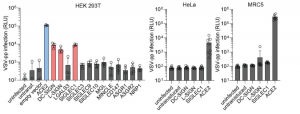A group from Vir Biotechnology, San Francisco, CA, 94158, USA, etc. has reported that C-type lectins (DC-SIGN and L-SIGN) and SIGLEC1 do not act as primary entry receptors of SARS-CoV-2, but act as attachment receptors.
https://www.nature.com/articles/s41586-021-03925-1
HEK293T were transfected with vectors encoding ACE2 or 13 selected lectins (DC-SIGN, L-SIGN, LGALS3, SIGLEC1, SIGLEC3, SIGLEC9, SIGLEC10, MGL, MINCLE, CD147, ASGR1, ASGR2, NRP1). Untransfected HEK293T cells were only weakly permissive to infection, and ACE2 overexpression led to a dramatic increase in pseudovirus entry. Increased infectivity was also observed in HEK293T cells following transfection with C-type lectins DC-SIGN and L-SIGN as well as with SIGLEC1. NRP-1 and CD147 did not enhance SARS-CoV-2 infection in these conditions. A SIGLEC1 blocking antibody inhibited infection of SIGLEC1 expressing HEK293T, supporting the role of this molecule as a new SARS-CoV-2 co-factor. The expression levels of these receptors change from cell to cell, and SIGLEC1 is highly expressed on moocytes, macrophages, and dendritic cells. Therefore, it was suggested that the trans-infection from SARS-CoV-2 attached these cells to target cells would be the most likely in an actual condition. The ectopic expression of DC-SIGN, L-SIGN and SIGLEC1 on HeLa and MRC5 cells did not support infection of ACE2 negative cells, indicating that these lectins do not act as primary entry receptors. Collectively, these data reveal a lectin-facilitated pathway of infection that is evident on cells expressing low levels of ACE2, supporting the notion that SARS-CoV-2 may use these lectins as attachment receptors to thether viral particles facilitating interaction with ACE2.
However, blog admin feels that this paper is lacking a view point of direct infection of SARS-CoV-2 to monocytes and macrophages through phagocytosis. In this case, Fcg receptors recognizing antibody-opsonized viral particles and also C-type lectins and Toll-like receptors recognizing aberrant glycans on SARS-CoV-2 would be key receptors responsible for the direct infection.

